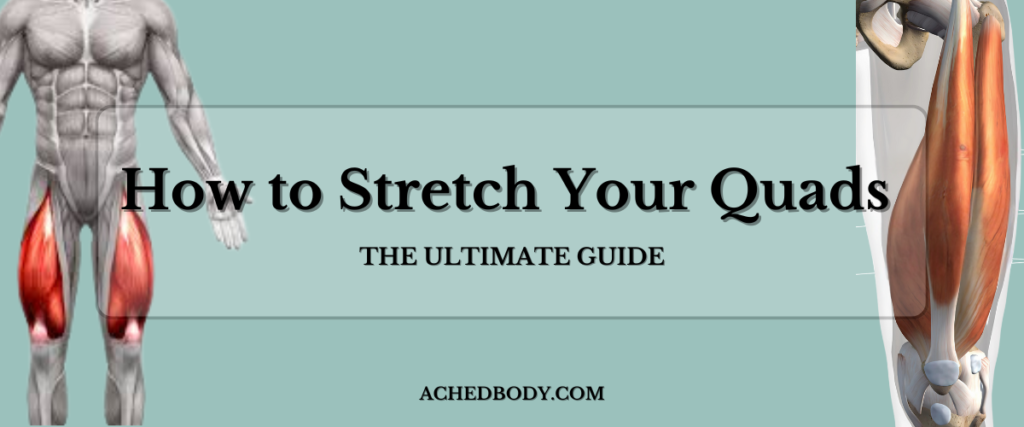
How to Stretch Your Quads (The Ultimate Guide)
Whatever reason you have for wanting to be more flexible, this quad stretching guide will give you what you need.
Your quadriceps (the group of four muscles at the front of your thigh) are major movers in every lower body activity: walking, running, squatting, jumping, cycling, and climbing stairs.
When they’re tight, everything from your overall posture to knee function can suffer.
In this guide, I break down the quad stretches that fix my legs, show you how to do them correctly, and which ones work best depending on your situation—whether you’re sore, stuck at a desk, or just trying to improve flexibility.
Let’s get to it.
Why Your Quads Get Tight
Quad tightness is one of those things that you just never seem to be able to get rid of. It’s common for active and sedentary people (for different reasons).
And this is all because the quad muscles have a lot of muscle mass and they are active every time you move your body.
If you sit for long periods of time, quad muscles become more stiff and shortened at the hip which impacts range of motion.
In fact, sitting for longer periods of time is associated with muscle shortening of the hip flexors and quadriceps, which contributes to anterior pelvic tilt and poor posture.
And if you’re active, quad tightness will develop from adhesion buildup to create quad trigger points…
Or in simple terms, muscle knots, as well as muscular imbalances that shorten muscles from improper range of motion in your exercises.
Tight quads can lead to:
- Knee pain and hip issues
- Poor posture (anterior pelvic tilt)
- Reduced athletic performance
So, before learning about trigger points and How to Foam Roll Your Quads, here are the best quad stretches I know and how to scale them to your specific needs.
Best Quad Stretches (With Instructions)
If you find that you feel the stretches in your hip flexors more than your quad, the tightest link in your body may be those hip flexors which you can read about here.
You also may need to change your position to target the quads more, or try a more advanced variation to deepen the stretch.
Deep Lunge – Quad Focus
This simple stretch targets both your quads and hip flexors, but we are trying to target the quadriceps.
Begin by kneeling on one leg with the other foot planted in front of you.
Shift your weight forward to feel a stretch along the front of your back leg. If the sensation is stronger in your hip or core area rather than your thigh, it could mean your hip flexors need extra attention too.
If this stretch doesn’t target your quads enough check out the next one for more intensity.
Couch Stretch
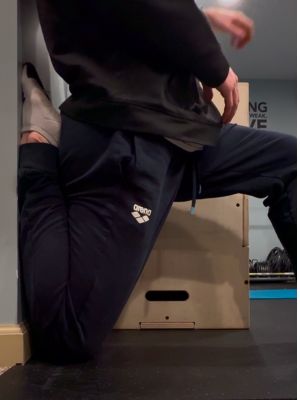
The couch stretch is my go to anytime I need a quad stretch and there is an open wall available.
Follow along with this video to get into the stretch and use the variations described below to deepen the stretch and change the target depending on where your tension is.
P.S. If this hurts your knee, get a pad to cushion the floor you’re on! And read this article about quad related knee pain!
Tuck hips, flatten back
The most common mistake people make when trying this stretch is that they are open in their hips when they do it.
Since some quad muscles cross over at the hip, you have to have your hips “tucked” in order to stretch the muscle fully. Look at the difference.
If you are able to get your hip tucked and stay upright, then you can go one step further with a flat back. You can see the space between my back and the wall in this picture below.
You have to contract your core muscles and create a flat back for the greatest possible stretch down the quad.
It’s tough to get into that position because it does require a good amount of flexibility, so take your time.
Hip away
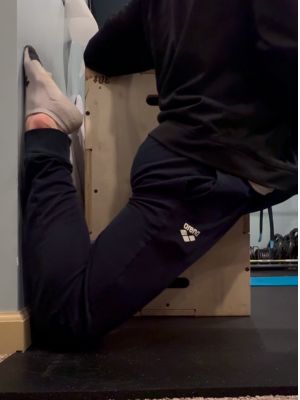
Moving your hip away can move the stretch down the leg a bit, but this can also be felt in the hip flexor too.
I like to take this time to rotate a little bit so that the inner and outer quad muscles get some target stretches too.
Arm up
In any of these variations, you can raise the arm on the same side that is being stretched to put the muscle in a more stretched state.
I also like to raise my arm when I do side bends and rotations to find the deep corners of the quad stretch!
Flex-relax cycles
This adds a PNF component to the couch stretch that will help inhibit the muscles natural instinct to resist the stretch.
If you don’t know what PNF stretching is, it is when you activate and relax a stretched muscle to get extra mobility and relaxation benefits.
Click here to learn more. (coming soon)
Once you are set up in the couch stretch, flex your quads as if you are trying to straighten your leg.
Do that for 10-15 seconds, then relax and sink into the stretch.
You should be able to go deeper with less resistance from the muscle.
Repeat as many times as you would like.
Pro Tip: make sure you breathe through all of the contractions and relaxation phases.
Add pressure against wall
The final variation of the couch stretch is to have something to push against with your other foot to force a deeper stretch. This requires something about three or four feet out in front of the wall you are using to get leverage.
You can see in the photo below, I am in the “couch stretch”, but I use the (place holder) to push against with my other leg.
This helps me push my body into the wall better which gives me a deeper stretch.
This is my preferred way of stretching my quads because it gives me some of the benefits of the balancing quad stretch (below) without using my hands!
Balancing Quad Stretch
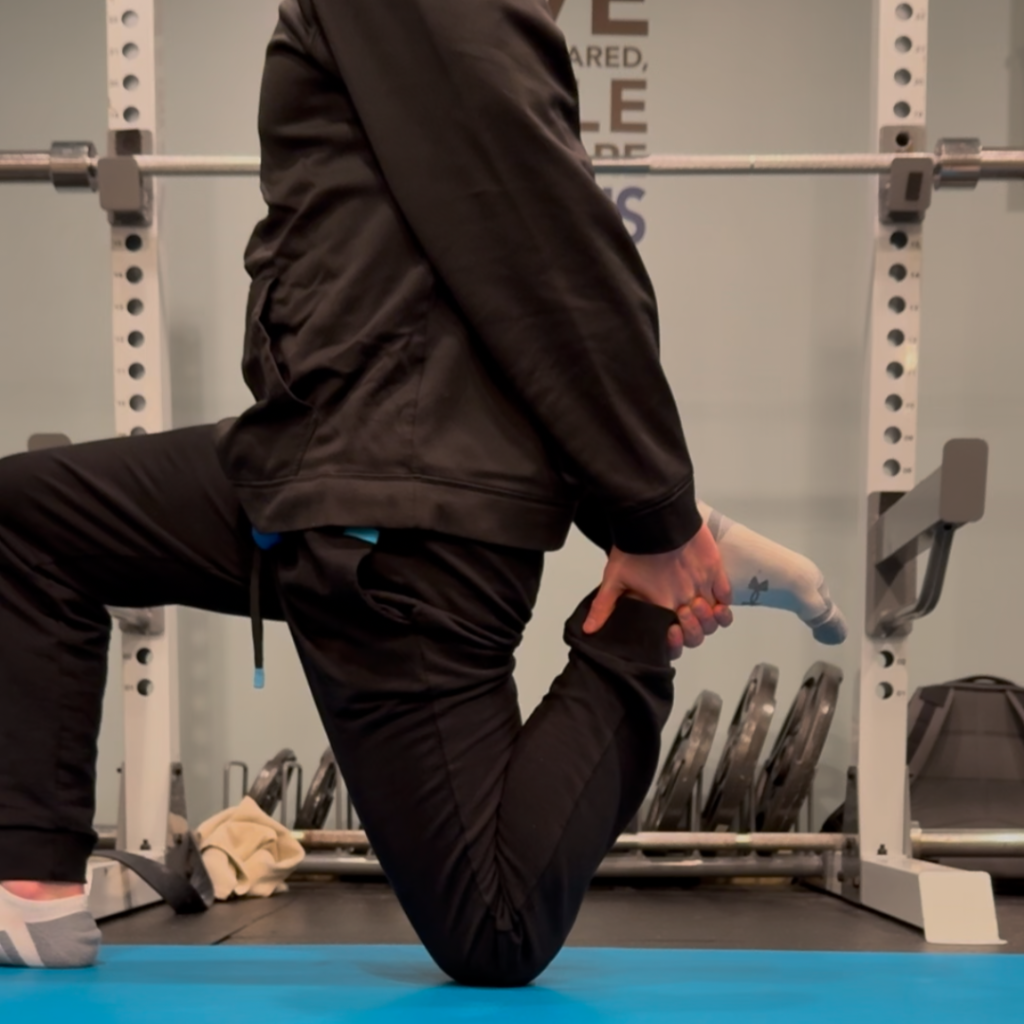
The balancing quad stretch is the couch stretch without the wall or couch to assist. You use your hands to grab your foot or ankle for manual stretching. This is what the basic version looks like:
You’ll notice that my hands are tightly gripping my ankle, with my foot inline with my glutes. This helps to avoid torquing your knee inward or outward.
Here are some extra ways to improve the stretch.
PNF version
We went over pnf stretching in the couch stretch section, but here is a full breakdown for more information on it.
PNF stretches are a form of stretching where you engage and relax the muscle that is being stretched to get extra mobility and relaxation benefits.
Here’s how:
As you grip your ankle, push against it for 10-15 seconds as if you are trying to kick your foot free towards the floor. Then relax your quads and use your hands to pull your heel closer to your hip.
Each time you do it, you should be able to sink a little deeper into the stretch.
- Tuck Hips
As noted in the couch stretch section, a common mistake happens when people try this stretch with open hips. See the difference?
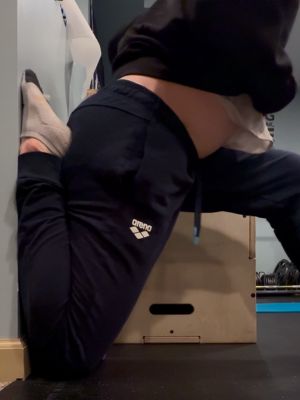

Some quad muscles cross over at the hip so if you want them to get the most stretch possible you have to have your hips “tucked”.
Keep your core and glutes engaged as much as possible to keep the hip and back in a stable ”tucked” position. You will feel the difference all the way down your leg!
- Head Nod Down
Finally, the last trick I have for making this stretch A+ is to lower your chin while doing the stretch.
After you are good at tucking your hips and breathing into the stretch, tilt your chin down like the pictures below and it will fire up either your quad or hip flexors more than before.
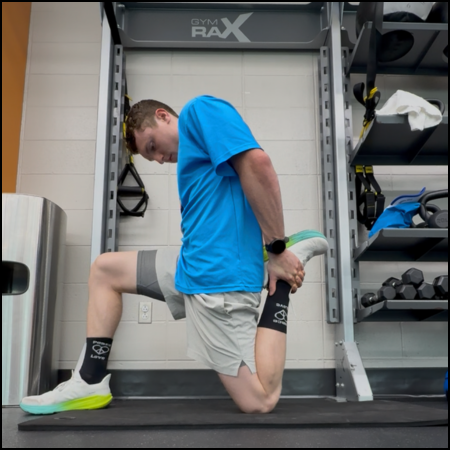
How to Stretch Sore Quads
You can stretch sore quads the same way you would go about stretching normally.
Use less force if you want a more gentle stretch.
How to Stretch Quads While Sitting
It isn’t ideal but you can sit in a chair on the edge of the seat, slide one foot back under the seat, and lean back a little bit to lengthen.
It’s not deep, but it helps during long workdays.
If possible, incorporate a small stretch routine on breaks or do sessions before and after work!
How to Stretch Outer or Inner Quads
Angle your hips slightly outward or inward during the couch stretch to target different muscle fibers.
In my opinion, the best way to reach those muscles is with trigger point therapy. Use my quad specific guide to learn how to do it yourself.
How to Stretch Upper Quads or Quad Tendon
Use the couch stretch outlined above while tucking your pelvis and squeezing your glute. That drives the stretch higher up the thigh.
You can also use the balancing quad stretch with your hips tucked and chin tilt to achieve similar results.
How Often Should You Stretch Your Quads?
If you are looking for serious changes in your flexibility or quality of life, you will want to stretch more than is usually recommended.
The typical guidelines say that 3 rounds of 30 seconds in a stretch is effective.
In my experience, several minutes per day is the best way to get lasting changes in flexibility and mobility.
With that said, if you’re someone who sits a lot, you should get at least 2 minutes in a deep quad stretch on each side every day.
If you are exercising regularly and sitting a lot for work, your quads will naturally tighten over time.
You can use dynamic stretches like deep lunges with a straight back leg before exercise and do a deeper stretch after your workout.
You don’t need to spend 20 minutes every day. Staying consistent is the best way to make a difference over time.
A 2021 meta-analysis showed that static stretching improved range of motion by 8–20% after just 2–4 weeks of consistent practice.
When to Avoid Quad Stretching
While stretching is generally safe, avoid aggressive quad stretches if:
- You have a recent quad strain or tear
- You feel sharp pain in the knee or hip while stretching
- You can’t maintain good posture during the stretch
If in doubt, ease off and focus on gentle mobility until you’re ready to go to the next level.
Final Thoughts
Stretching your quads is simple—but don’t underestimate how powerful it can be for unlocking better movement.
Add these into your daily routine and you’ll start feeling the difference in how your body moves and recovers.
As always, ask any questions you have in the comments and let me know if you need anything!
-Nick